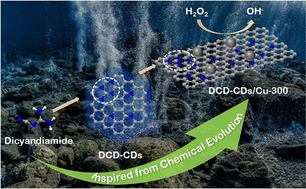Cu(ii)-assisted self-assembly of dicyandiamide-derived carbon dots: construction inspired from chemical evolution and its H2O2 sensing application†
Abstract
In the rapid development of artificial nanomaterials comparable to biological enzymes, we propose herein a novel concept for the construction of functional materials inspired from chemical evolution. To mimic the formation process of the catalytic system for the origin of life, dicyandiamide (DCD) was used as an elemental molecule for the de novo synthesis of an electrocatalyst. DCD was initially condensed with glucose (Glu) to form carbon dots (CDs) via a hydrothermal method. The self-assembly of the DCD-derived CDs was then modulated by introducing copper ions and a controlled pyrolysis process. Carbonization of the self-organized DCD-CDs/Cu at 300 °C in air produced the resultant catalyst (DCD-CDs/Cu-300) with the crystalline properties of a transitional state from an organic to inorganic matter, possessing a well-tuned chemical composition and the enhanced electrochemical signal of H2O2 reduction. Therefore, the DCD-CDs/Cu-300 modified electrode provides satisfactory analytical performance for trace H2O2 quantification with a wider linear range (1.0 × 10−7 to 1.4 × 10−3 M) and low detection limit (6.4 × 10−8 M, S/N = 3). This facile electrocatalyst construction strategy inspired from chemical evolution is expected to pave the way to form a more unified paradigm by integrating nanotechnology.

- This article is part of the themed collection: Analyst HOT Articles 2022


 Please wait while we load your content...
Please wait while we load your content...